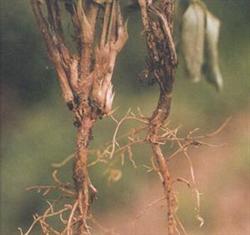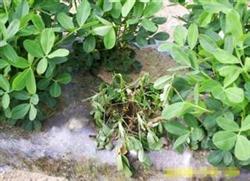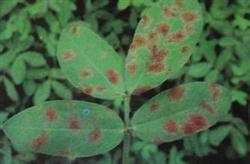Occurrence and Control techniques of Peanut Stem Rot

In recent years, the planting area of peanut in our region has increased year by year, and the peanut disease has also increased year by year, especially the harm of peanut stem rot has increased rapidly. According to the investigation and statistics, from 2001 to 2003, the incidence of the disease accounted for 89.6%, the rate of mild diseased plants was 10-20%, serious ones could reach more than 60%, and even died in pieces without harvest. According to the experience in recent years, the harm and prevention measures are introduced as follows: first, harm to the symptoms. The incidence of stem rot is mainly in the meristem of the first pair of lateral branches or in the middle and upper part of the rhizome. At the seedling stage, the pathogen first infected the cotyledons, causing 2 cotyledons to rot, and then infected the base of the stem close to the ground or the underground rhizome to produce yellowish-brown water-stained spots, which gradually expanded into large patches and showed black. and around the stem spread into a ring of disease spots, so that the vascular bundle rot. In the early stage of infection, the color of the aboveground leaves became lighter, the petiole sagged at noon, the compound leaves closed, and the leaves could recover in the morning, but with the development of the disease, the petioles all collapsed and the whole stem wilted. It turns yellowish brown and dies in dry weather, and on rainy days, the diseased plants rot and turn dark brown. It takes about 3-4 days from symptom appearance to death in seedling stage, and 10-40 days from symptom appearance to death in other growth stages. Second, the source of pathogenic bacteria. Soil carrying bacteria and seed mildew cover are the main sources of stem rot, usually the carrying rate of seeds is about 2%, while the carrying rate of pods and kernels is more than 37% and 65% respectively. Soil fertilizer mixed with diseased plants and soil in diseased areas are important sources of bacteria for infection, transmission and spread. Third, prevention and control measures 1. Ensure seed quality and control seed mildew. Peanuts for planting should be harvested at the right time, turned in the sun in time, stored safely, and beware of mildew. Seed drying and seed selection were carried out before sowing to remove spoiled and moldy seeds and ensure seed quality so as to reduce the initial infection of the disease. 2. Reasonable rotation. Rational crop rotation is the basic measure to control diseases. In the land with mild disease, the control effect can be achieved by crop rotation every other year, and the serious disease area must be rotated for more than 3 years in order to significantly reduce the disease. Wheat, corn and sweet potato are the best rotation crops. 3. Apply rotten fertilizer. Soil manure and livestock manure mixed with diseased remains cannot be applied directly. Retting must be done to reduce the source of bacteria as much as possible. 4. Chemical control. At present, the most effective method is to mix seeds with carbendazim, soak seeds or spray them. Mix seeds with 25% or 5% carbendazim wettable powder, 0.5% or 0.3% of the seed amount, respectively. First wet the seeds with water and then mix with the powder, so that the powder uniformly adhere to the surface of the seed, and then sow. Soak the seeds with 25% or 50% wettable powder carbendazim, soak the seeds according to 1% or 0.5% of the seed amount, use 25-30 kg of water, mix the powder in water and then add 50 kg of seeds for 24 hours, and turn it several times, so that the seeds will completely absorb the potion and sow. The effect of spray is worse than that of seed soaking and seed dressing, but it can be used as a remedial measure to prevent peanut seedling disease. Carbendazim with 25% or 50% wettable powder was used to prepare 500-fold or 1000-fold solution respectively, or 70% methyl topiramate was sprayed after the whole peanut seedling, and then sprayed again before flowering, which could basically inhibit the spread of the disease. The use of the above agents also has a good control effect on root rot and black mold.
- Prev

Heavy Control of Bacterial Wilt in Peanut Flowering and Needle Falling Stage
Peanut bacterial wilt is a devastating disease. Once infected, the whole plant dies and cannot be cured. During flowering and needle dropping period of peanut is the outbreak period of bacterial wilt, during which attention should be paid to spraying control. Specific control methods: When peanuts begin to bud, spray 1500 times 70% hymexiline solution on leaves every 10~15 days.
- Next

Peanuts beware of early defoliation
The early defoliation of peanut leaf spot disease in the later stage will seriously affect the yield of peanut, and the main cause of early defoliation of peanut in the later stage is the harm of plant premature senescence and leaf spot disease (net spot, brown spot, etc.). The peanut leaves that were sprayed with paclobutrazol and containing this component regulator were earlier and more severe. Therefore, prevent early peanuts.
Related
- The first cup of black tea in spring, the flavor and history of tea gardens in Kenya, Africa
- The computer can not only choose potatoes, but also grow tea rice. AI will grow winter oolong tea champion.
- It is not only the inflated tea bitten by insects, but also engraved with the four seasons tea in Beipu.
- The Oriental Beauty Tea Festival in Zhuxian County takes the stage at the weekend to experience the plus-size feast of oil tea.
- & quot; Oriental Beauty Tea & Exploration of Emei in Hsinchu, the hometown of quot;
- The new variety of strawberry "Tainong 1" dessert is the first choice with mellow aroma. Crimson gorgeous
- History of Tea in Taiwan: from Wild Inner Mountain to Export Tea Garden
- Two types of Taiwan Oriental Beauty Black Tea won the British three-Star Award for Childhood Tea Xiang Zhang Jiaqi changed from pilot to champion tea maker.
- Banana species and varieties: the planting history of Taiwan Xianren banana and dwarf banana is long, is banana disease resistant?
- Coffee planting Technology: Qianjie Coffee from Seedling to harvesting

